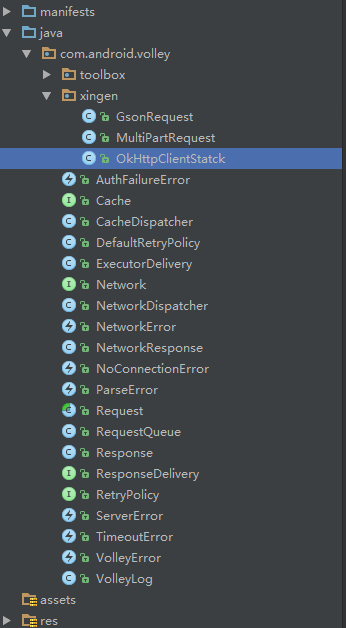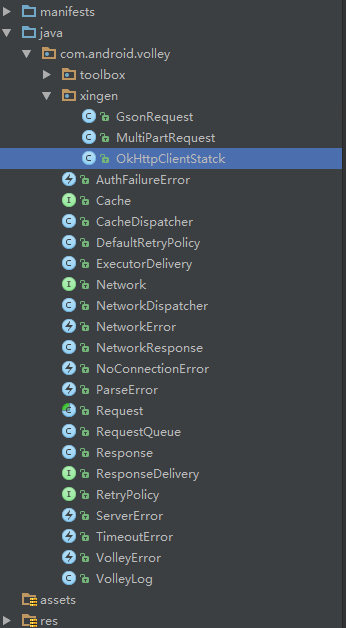Volley+OkHttp+Gson自定義框架
本篇部落格內容:
在前面兩篇部落格,已經記錄如何自定義專案需求的請求。這裡來講解如何修改Volley原始碼,自定義需求框架。
1.先來了解下Volley部分原始碼:
在Volley.java中,可以看到一些配置,例如聯網操作類(HttpURLConnection或者androids-http-clients),磁碟快取,執行緒池(實際上是4個網路執行緒,一個快取執行緒)。
/**
* 用途:
* 初始化Volley中網路配置,非同步執行緒配置,磁碟快取配置
*/
public class Volley {
/** Default on-disk cache directory. 預設快取的資料夾名*/ 從上面原始碼可知,噹噹前手機系統的api>=9 時候,volley才有HttpURLConnection來連線伺服器。磁碟快取,執行緒池這裡暫時省略不講解。接下來了解下,HurlStack這類。
HurlStack這個類包括了這幾個操作,設定請求的header和body,以及讀取響應資料。
/**
* An {@link HttpStack} based on {@link HttpURLConnection}.
*
* 用途:
* 用HttpURLConnection作為聯網通訊類。
*/
public class HurlStack implements HttpStack {
...................//部分原始碼未貼出
/**
* 執行HttpURLConnection,返回HttpResponse
*
* @param request the request to perform
* @param additionalHeaders additional headers to be sent together with
* {@link Request#getHeaders()}
* @return
* @throws IOException
* @throws AuthFailureError
*/
@Override
public HttpResponse performRequest(Request<?> request, Map<String, String> additionalHeaders)
throws IOException, AuthFailureError {
...................//部分原始碼未貼出
String url = request.getUrl();
//建立一個HttpUrlConnection或者其子類,進行網路連線。
URL parsedUrl = new URL(url);
HttpURLConnection connection = openConnection(parsedUrl, request);
//新增Http的標頭
for (String headerName : map.keySet()) {
connection.addRequestProperty(headerName, map.get(headerName));
}
//根據volley中請求,來設定HttpUrlConnection的連線方式,和傳遞的內容
setConnectionParametersForRequest(connection, request);
...................//部分原始碼未貼出
}
/**
* Opens an {@link HttpURLConnection} with parameters.
* @param url
* @return an open connection
* @throws IOException
*
* 根據url中帶有的協議,來開啟一個帶有引數的HttpURLConnection,或者HttpsURLConnection
*/
private HttpURLConnection openConnection(URL url, Request<?> request) throws IOException {
HttpURLConnection connection = createConnection(url);
int timeoutMs = request.getTimeoutMs();
//設定連線時間
connection.setConnectTimeout(timeoutMs);
//設定讀取時間
connection.setReadTimeout(timeoutMs);
//不設定http快取
connection.setUseCaches(false);
connection.setDoInput(true);
// use caller-provided custom SslSocketFactory, if any, for HTTPS
// 若是HTTPS協議,則使用HttpsURLConnection進行連線,且新增自定義的SSLSocketFactory
if ("https".equals(url.getProtocol()) && mSslSocketFactory != null) {
((HttpsURLConnection)connection).setSSLSocketFactory(mSslSocketFactory);
}
return connection;
}
/**
* Create an {@link HttpURLConnection} for the specified {@code url}.
* 通過URL開啟一個客戶端與url指向資源的間的網路通道。
*/
protected HttpURLConnection createConnection(URL url) throws IOException {
return (HttpURLConnection) url.openConnection();
}
/**
* 若是請求中存在Body(post傳遞的引數),則寫入body到流中。
* @param connection
* @param request
* @throws IOException
* @throws AuthFailureError
*/
private static void addBodyIfExists(HttpURLConnection connection, Request<?> request)
throws IOException, AuthFailureError {
byte[] body = request.getBody();
if (body != null) {
//設定post請求方法,允許寫入客戶端傳遞的引數
connection.setDoOutput(true);
//設定標頭的Content-Type屬性
connection.addRequestProperty(HEADER_CONTENT_TYPE, request.getBodyContentType());
DataOutputStream out = new DataOutputStream(connection.getOutputStream());
//寫入post傳遞的引數
out.write(body);
out.close();
}
}
}從上面原始碼可知:
1.建立HttpUrlConnection物件時通過createConnection(URL url)來實現的
2.新增請求的body會在addBodyIfExists()內呼叫request.getBody()來實現
3.新增請求的標頭Content-type是呼叫request.getBodyContentType()來實現的。
瞭解聯網操作類HttpUrlConnection如何建立,如何新增請求的Body和Header,便可以知道如何修改Volley原始碼。
2.使用OkHttp作為傳輸層:
OkHttp的描述:一個http+spdy的客戶端,可以用於android 和java運用程式。
OkHttp的優勢:
Http/2 支援允許全部(訪問同一主機的)請求共享一個socket.
連線池減少請求延遲(若是Http/2不能使用)
3.資料壓縮成GZIP格式,來縮小下載大小。
4.響應快取可以避免重複(已經完成的網路操作的)請求
5.OkHttp perseveres,正當網路是麻煩:
它會默默地從常見連線問題池中恢復。
若是你的伺服器有多個IP地址,當第一次連線失敗,OkHttp會嘗試使用備用地址。
這是必需的,對於IP4+IP6和(沉珂資料中的)主機服務- OkHttp初始化新連線是通過現今TLS功能(SNI,ALPN),若是握手失敗,則回退到TLS1.0中
- 使用Okhttp是容易的,它的請求/響應的API是被設計成流暢builder和immutability.
它支援同步阻塞回調和非同步回撥。
OkHttp的版本變化:
OkHttp1.x 存在一些問題:
問題: OkHttp changes the global SSL context, breaks other HTTP clients
原因:OkHttp更改全域性的SSL context,打斷其他Http客戶端
解決方式:建立自己的SSL context,不使用系統預設的。但是存在問題,自定義的SSLcontext會失去自定義的屬性,這可能打破一些特徵,例如證書固定。/** * 自定義一個SSLContext,而不使用預設的。 * * @return */ public static OkHttpClient createOkHttpClient(){ OkHttpClient okHttpClient=new OkHttpClient(); try { SSLContext sslContext = SSLContext.getInstance("TLS"); sslContext.init(null, null, null); okHttpClient.setSslSocketFactory( sslContext.getSocketFactory()); //避免OkHttp與UrlHttpConnection混合,出現某些方法找不到 //參考連結:https://github.com/square/okhttp/issues/673 URL.setURLStreamHandlerFactory(okHttpClient); ; } catch (GeneralSecurityException e) { throw new AssertionError(); // The system has no TLS. Just give up. } return okHttpClient; }獲取HttpUrlConnection物件的方式:okHttpClient.open(url)
OkHttp2.x 存在一些問題:版本2.x修復以上的問題,但是仍然存在些問題:
問題:java.io.IOException: stream was reset: PROTOCOL_ERROR
原因:導致原因: OkHttp 傳送標頭使用的格式:accept-encoding: gzip 。 這導致nginx伺服器報告一個protocol error
解決方式:http://mailman.nginx.org/pipermail/nginx/2015-October/048978.html// 強迫使用HTTP1.1: OkHttpClient client = new OkHttpClient(); // Disable HTTP/2 for interop with NGINX 1.9.5. client.setProtocols(Collections.singletonList(Protocol.HTTP_1_1));獲取HttpUrlConnection物件的方式:OkUrlFactory(okHttpClient).open()
OkHttp3.x 版本已經比較成熟,實用起來也比較方便,通過構建者方式來建立物件。
原本打算都講解下如何讓OkHttp各個版本作為Volley的傳輸層,但是考慮到大多數人都是使用OkHttp3.x。故這裡就不在講解如何實現各個版本的OkHttp作為傳輸層。
先在Volley原始碼的Gradle中新增依賴庫:
dependencies {
//OkHttp庫
compile 'com.squareup.okhttp3:okhttp:3.5.0'
//okhttp-urlconnection庫
compile 'com.squareup.okhttp3:okhttp-urlconnection:3.5.0'
//Gson庫
compile 'com.google.code.gson:gson:2.2.4'
}然後,建立一個OkHttpClientStatck,來作為傳輸層(若是有需要的,可以在原始碼下自定義一個包,在包下建立)

思路:採用OkHttp作為傳輸層,替代原生的HttpUrlConnection。
實現方式:繼承HurlStack 類,複寫createConnection(URL url)返回OkHttpClient中的HttpURLConnection
OkHttpClientStatck.java完整程式碼如下:
/**
* Created by ${新根} on 2016/11/3.
* 部落格:http://blog.csdn.net/hexingen
*
* 採用OkHttp作為傳輸層,替代原生的HttpUrlConnection
*/
public class OkHttpClientStatck extends HurlStack {
private OkHttpClient okHttpClient;
/**
* 採購構建者方式建立OkHttpClient
* OkHttpClient可以自定義攔截器,快取,聯網時間和寫入時間等設定。
* Volley預設有這些東西,這裡就不在設定。
*/
public OkHttpClientStatck(){
OkHttpClient.Builder builder=new OkHttpClient.Builder();
okHttpClient=builder.build();
}
/**
* 獲取到OkHttpClient();
* @return
*/
private OkHttpClient getOkHttpClient(){
return okHttpClient;
}
/**
* 這裡採用OkHttp框架中HttpURLConnection,而不使用原生的。
*
* OkHttpClient1.x:通過OkHttpClient.open(url)來獲取
*
* OkHttpClient2.x:可以通過OkUrlFactory.open(URL url)來獲取
*
* @param url
* @return
* @throws IOException
*/
@Override
protected HttpURLConnection createConnection(URL url) throws IOException {
String protocol= url.getProtocol();
if (protocol.equals("http")) return new OkHttpURLConnection(url, getOkHttpClient(),null);
if (protocol.equals("https")) return new OkHttpsURLConnection(url, getOkHttpClient(),null);
throw new IllegalArgumentException("Unexpected protocol: " + protocol);
}
}然後將OkHttpClientStatck新增到Volley中,作為預設的傳輸層:
在Volley.java中修改如下:
public class Volley {
............//部分原始碼未貼出
/**
* Creates a default instance of the worker pool and calls {@link RequestQueue#start()} on it.
*
* @param context A {@link Context} to use for creating the cache dir.
* @return A started {@link RequestQueue} instance.
*
* 建立一個預設的工作池物件,且呼叫RequestQueue的start()
* 引數Contentxt用於建立磁碟快取的資料夾
*
*/
public static RequestQueue newRequestQueue(Context context) {
//修改原始碼:這裡採用OkHttp作為傳輸層
return newRequestQueue(context, new OkHttpClientStatck());
}
}有人好奇為什麼不用系統預設的HttpUrlConnetion,而用OkHttp作為傳輸層?
單純的HttpUrlConnetion的使用起來存在一些問題,OkHttp不止針對其問題做了處理,還對連線伺服器過程中一些問題做了處理。
Volley與OkHttp的整合已經完成了,整合後的Volley框架使用起來和原本的一樣,自我鼓勵下。
3.新增自定義的Request:
既然改了Volley的傳輸層,那再改Request也是順手之勞。
在框架原始碼中,新增 GsonRequest,這裡不再貼程式碼,感興趣的可以閱讀Gson解析的 GsonRequest
在框架原始碼中,新增 檔案上傳的MultiPartRequest ,這裡有部分程式碼進行了修改,原本是上傳檔案的byte[],變成了上傳file。省略了轉化過程,使用起來更方便。
完整程式碼程式碼如下:
/**
* Created by 新根 on 2016/8/9.
* 用途:
* 各種資料上傳到伺服器的內容格式:
* <p/>
* 檔案上傳(內容格式):multipart/form-data
* String字串傳送(內容格式):application/x-www-form-urlencoded
* json傳遞(內容格式):application/json
*
* 部落格:http://blog.csdn.net/hexingen
*/
public class MultiPartRequest<T> extends Request<T> {
private static final String TAG=MultiPartRequest.class.getSimpleName();
/**
* 解析後的實體類
*/
private final Class<T> clazz;
private final Response.Listener<T> listener;
/**
* 自定義header:
*/
private Map<String, String> headers;
private final Gson gson = new Gson();
/**
* 字元編碼格式
*/
private static final String PROTOCOL_CHARSET = "utf-8";
private static final String BOUNDARY = "----------" + System.currentTimeMillis();
/**
* Content type for request.
*/
private static final String PROTOCOL_CONTENT_TYPE = "multipart/form-data; boundary=" + BOUNDARY;
/**
* 檔案列表。引數1是檔名,引數2是檔案
*/
private Map<String, File > fileList;
/**
* 多個檔案間的間隔
*/
private static final String FILEINTERVAL = "\r\n";
public MultiPartRequest(int method, String url,
Class<T> clazz,
Response.Listener<T> listener, Response.ErrorListener errorListenerr) {
super(method, url, errorListenerr);
this.clazz = clazz;
this.listener = listener;
headers = new HashMap<>();
fileList = new HashMap<>();
}
@Override
protected Response<T> parseNetworkResponse(NetworkResponse response) {
try {
String json = new String(
response.data,
"utf-8");
T t = gson.fromJson(json, clazz);
return Response.success(t, HttpHeaderParser.parseCacheHeaders(response));
} catch (UnsupportedEncodingException e) {
return Response.error(new ParseError(e));
} catch (JsonSyntaxException e) {
return Response.error(new ParseError(e));
}
}
@Override
protected void deliverResponse(T t) {
listener.onResponse(t);
}
/**
* 重寫getHeaders(),新增自定義的header
*
* @return
* @throws AuthFailureError
*/
@Override
public Map<String, String> getHeaders() throws AuthFailureError {
return headers;
}
/**
* 設定請求的標頭
* @param key
* @param content
* @return
*/
public Map<String, String> setHeader(String key, String content) {
if (!TextUtils.isEmpty(key) && !TextUtils.isEmpty(content)) {
headers.put(key, content);
}
return headers;
}
/**
* 新增檔名和檔案資料
*
* @param fileName
* @param file
*/
public void addFile(String fileName, File file) {
if (!TextUtils.isEmpty(fileName) && file != null) {
fileList.put(fileName, file);
}
}
/**
* 重寫Content-Type:設定為json
*/
@Override
public String getBodyContentType() {
return PROTOCOL_CONTENT_TYPE;
}
/**
* post引數型別
*/
@Override
public String getPostBodyContentType() {
return getBodyContentType();
}
/**
* post引數
*/
@Override
public byte[] getPostBody() throws AuthFailureError {
return getBody();
}
/**
* 將string編碼成byte
*
* @return
* @throws AuthFailureError
*/
@Override
public byte[] getBody() throws AuthFailureError {
byte[] body;
ByteArrayOutputStream outputStream = null;
try {
outputStream = new ByteArrayOutputStream();
Set<Map.Entry<String, File>> set = fileList.entrySet();
int i=1;
for (Map.Entry<String,File> entry : set) {
//新增檔案的頭部格式
writeByte(outputStream, getFileHead( entry.getKey()));
//新增檔案資料
writeByte(outputStream,fileTranstateToByte(entry.getValue()));
//新增檔案間的間隔
if (set.size() > 1&&i<set.size()) {
i++;
Log.i(TAG,"新增檔案間隔");
writeByte(outputStream, FILEINTERVAL.getBytes(PROTOCOL_CHARSET));
}
}
writeByte(outputStream, getFileFoot());
outputStream.flush();
body = outputStream.toByteArray();
return body == null ? null : body;
} catch (Exception e) {
return null;
} finally {
try {
if (outputStream != null) {
outputStream.close();
}
} catch (Exception e) {
}
}
}
/**
* 將file轉成byte[]資料
*/
public byte[] fileTranstateToByte(File file){
byte[] data=null;
FileInputStream fileInputStream=null;
ByteArrayOutputStream outputStream = null;
try {
fileInputStream=new FileInputStream(file);
byte[] buffer=new byte[1024];
int length=0;
while ((length=fileInputStream.read(buffer))!=-1){
outputStream.write(buffer,0,length);
}
outputStream.flush();
data= outputStream.toByteArray();
}catch (Exception e){
data=null;
e.printStackTrace();
}finally {
try {
if (outputStream != null) {
outputStream.close();
}
if(fileInputStream!=null){
fileInputStream.close();
}
} catch (Exception e) {
}
}
return data;
}
public void writeByte(ByteArrayOutputStream outputStream, byte[] bytes) {
if(bytes!=null){
outputStream.write(bytes, 0, bytes.length);
}
}
/**
* 獲取到檔案的head
*
* @return
*/
public byte[] getFileHead(String fileName) {
try {
StringBuffer buffer = new StringBuffer();
buffer.append("--");
buffer.append(BOUNDARY);
buffer.append("\r\n");
buffer.append("Content-Disposition: form-data;name=\"media\";filename=\"");
buffer.append(fileName);
buffer.append("\"\r\n");
buffer.append("Content-Type:application/octet-stream\r\n\r\n");
String s = buffer.toString();
return s.getBytes("utf-8");
} catch (Exception e) {
e.printStackTrace();
return null;
}
}
/**
* 獲取檔案的foot
*
* @return
*/
public byte[] getFileFoot() {
try {
StringBuffer buffer = new StringBuffer();
buffer.append("\r\n--");
buffer.append(BOUNDARY);
buffer.append("--\r\n");
String s = buffer.toString();
return s.getBytes("utf-8");
} catch (Exception e) {
return null;
}
}
}
最終專案結構如下:

總結:
1. Volley框架的設計是相當不錯的,具備1個快取執行緒,4個網路執行緒,可以避免相同的Url的請求併發訪問伺服器
2. Volley框架帶有圖片處理ImageLoader,防止在ImageView在listview,gridview,recycleview中錯亂。
3. Volley也帶有磁碟快取,可以自行配置記憶體快取。
4. OkHttp也是帶有磁碟快取(需配置),非同步或者同步執行,請求重試,攔截器等等。
這篇 Volley+OkHttp+Gson結合使用,較為適合普通專案中需求。例如加上斷點續傳,下載大資料的檔案(volley不具備的優勢),還可以繼續深入的修改結合使用。慢慢長征路,還需繼續走下去。
